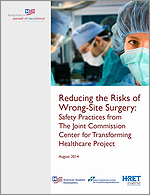Reducing the Risks of Wrong-Site Surgery: Safety Practices from The Joint Commission Center
 Although rare and difficult to study, wrong-site surgery is a serious risk recognized by health care organizations. Health care organizations in a variety of settings must manage the risks of wrong-site surgery to ensure the safety of patients. Preventing wrong-site surgery—which includes wrong-patient, wrong-procedure and wrong-side surgeries—is accomplished by creating a culture of safety and improving perioperative processes.
Although rare and difficult to study, wrong-site surgery is a serious risk recognized by health care organizations. Health care organizations in a variety of settings must manage the risks of wrong-site surgery to ensure the safety of patients. Preventing wrong-site surgery—which includes wrong-patient, wrong-procedure and wrong-side surgeries—is accomplished by creating a culture of safety and improving perioperative processes.
As part of the Joint Commission Center for Transforming Healthcare wrong-site surgery project, eight U.S. hospitals and ambulatory surgery centers measured the risk of wrong-site surgery in their perioperative processes, pinpointed the contributing causes and developed specific solutions targeted to each one. As a result, the health care organizations significantly reduced the number of surgical cases with risks for wrong-site surgery in four main areas: scheduling, pre-op/holding, operating room and organizational culture. Additional hospitals and ambulatory surgery centers that tested the work of the original organizations experienced the same improved results.
The provider organziations are:
- AnMed Health, Anderson, S.C.
- Center for Health Ambulatory Surgery Center, Peoria, Ill.
- Holy Spirit Hospital, Harrisburg, Pa.
- La Veta Surgical Center, Orange, Calif.
- Mount Sinai Medical Center, New York, N.Y.
- Rhode Island Hospital, Providence, R.I.
- Seven Hills Surgery Center, Henderson, Nev.
- Thomas Jefferson University Hospital, Philadelphia, Pa.
This report describes the types of risks for wrong-site surgery, their root causes and targeted solutions.

